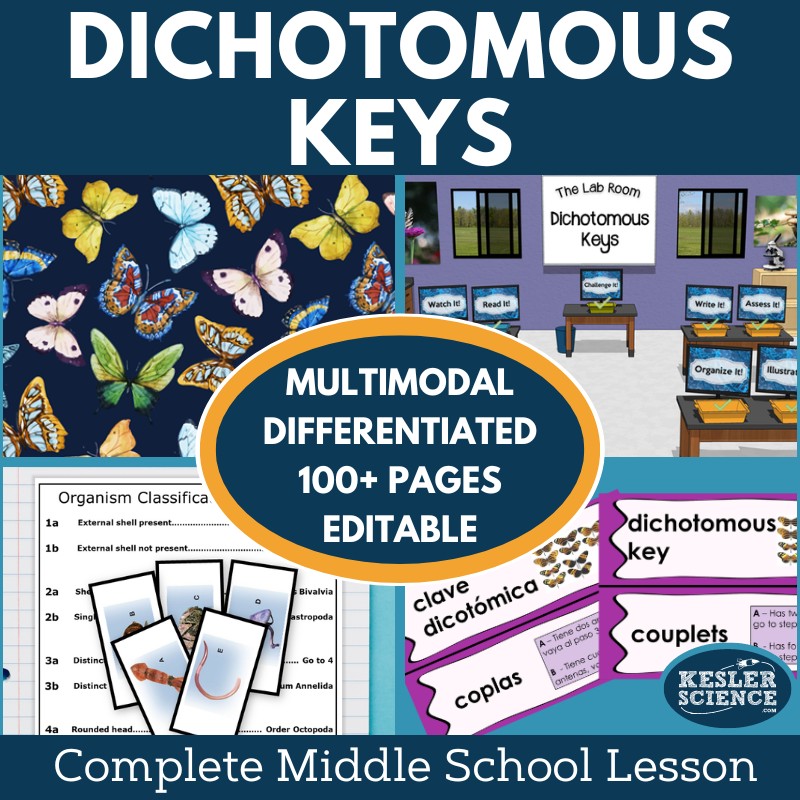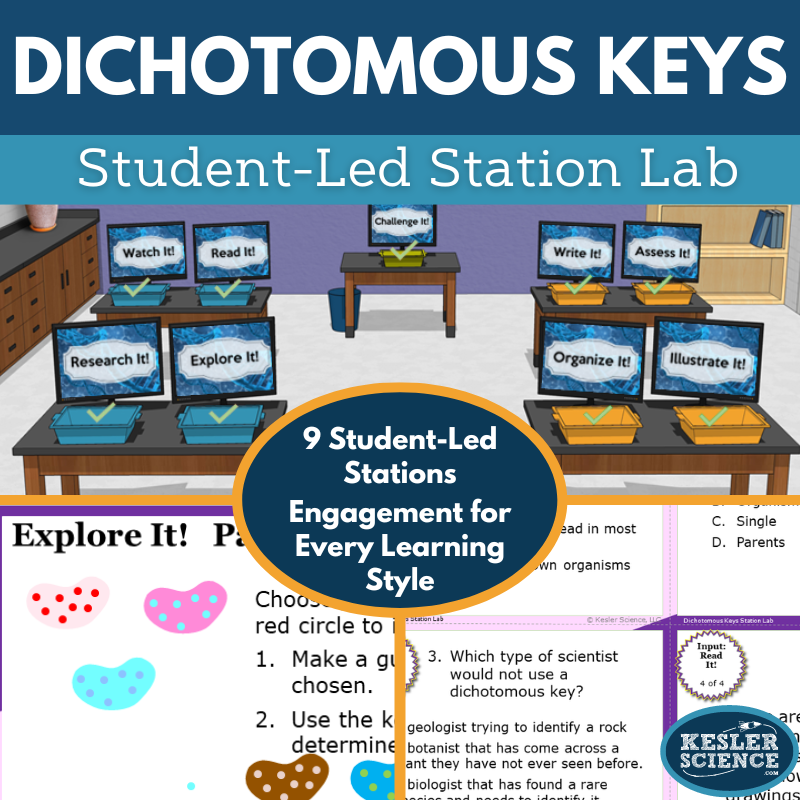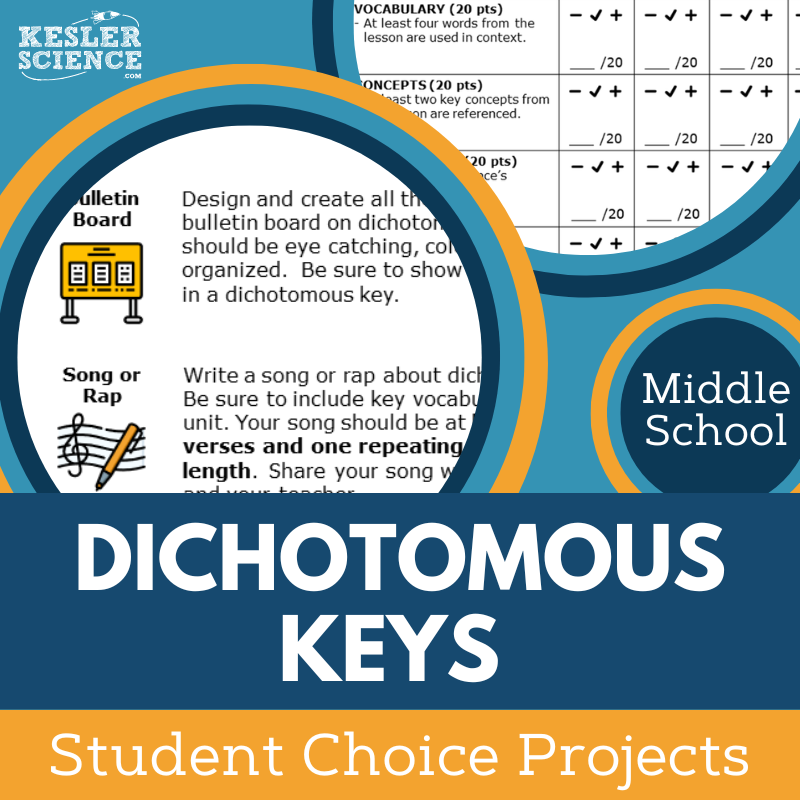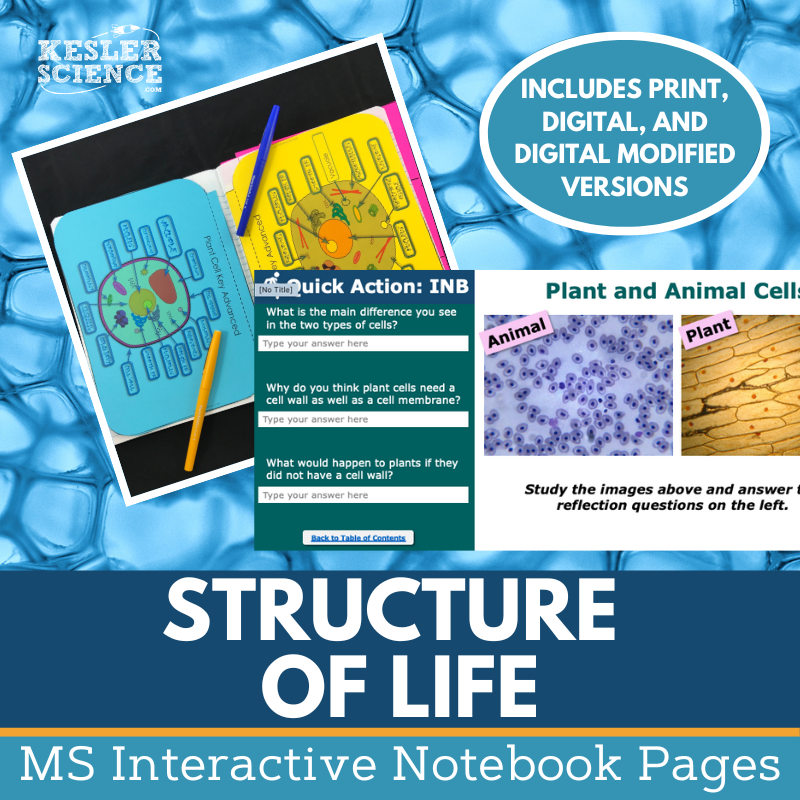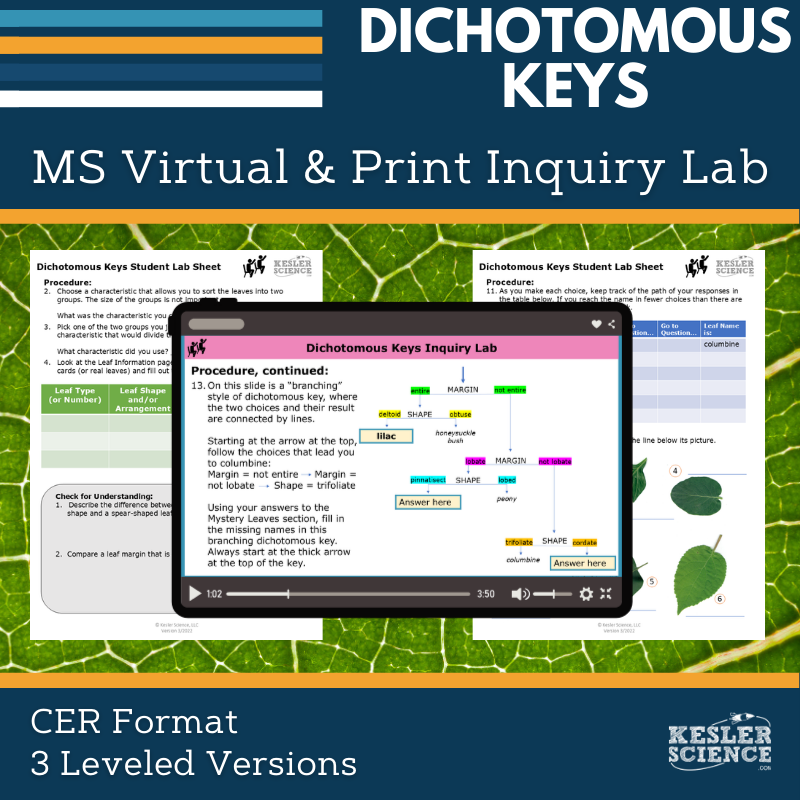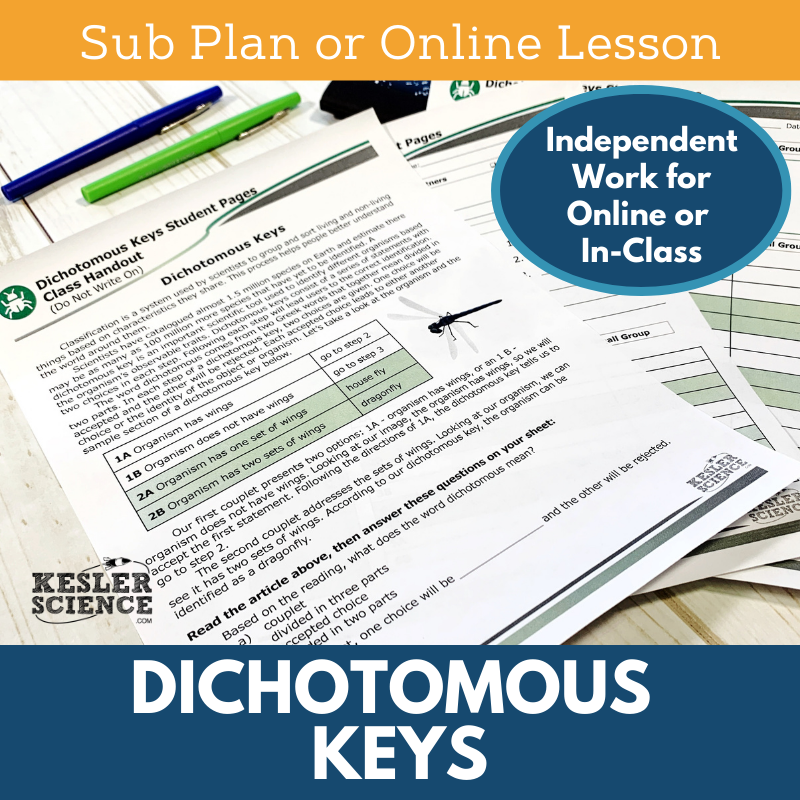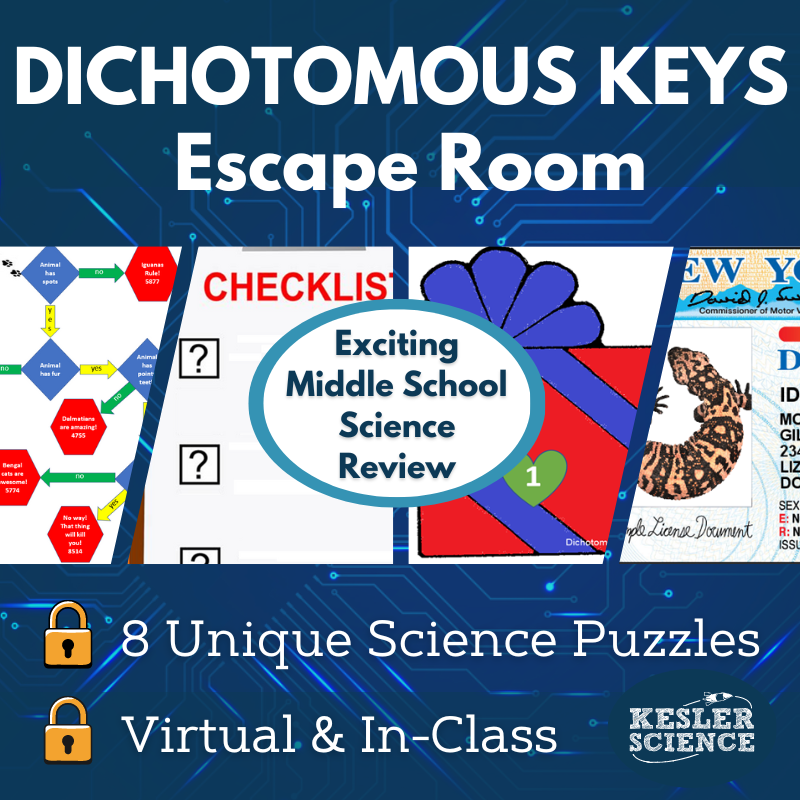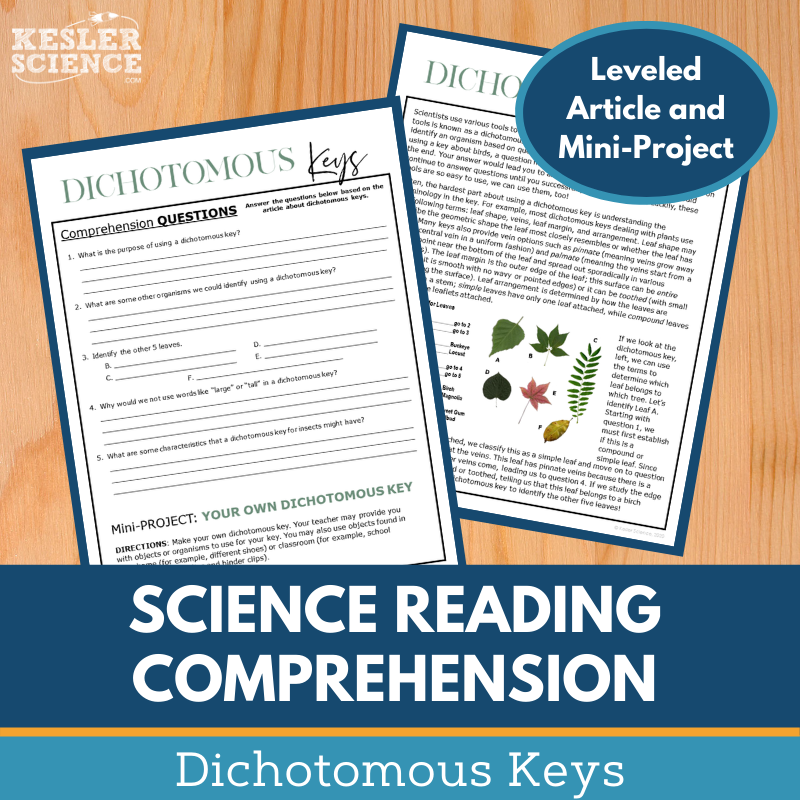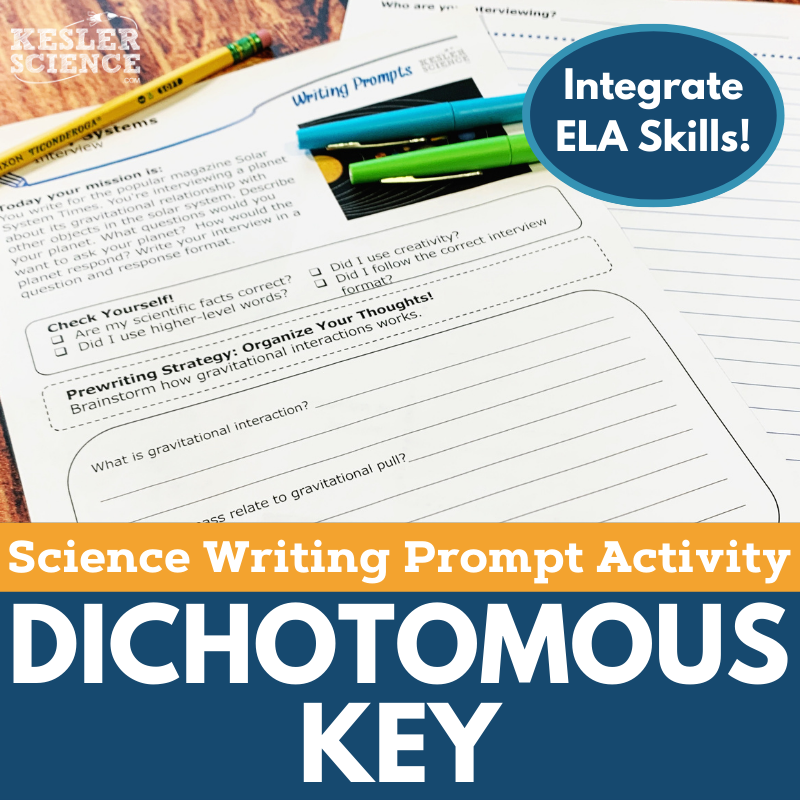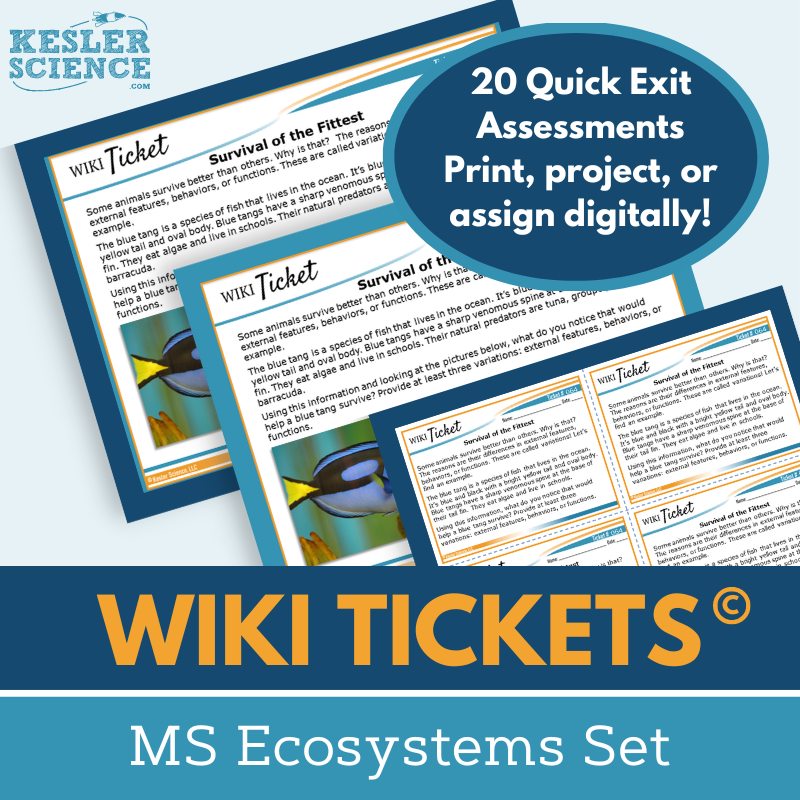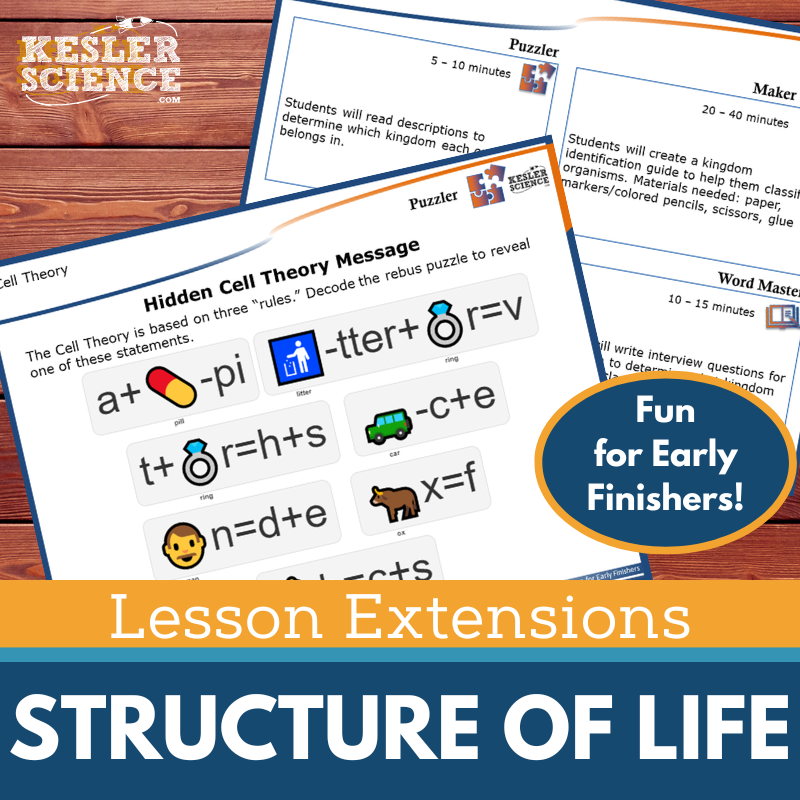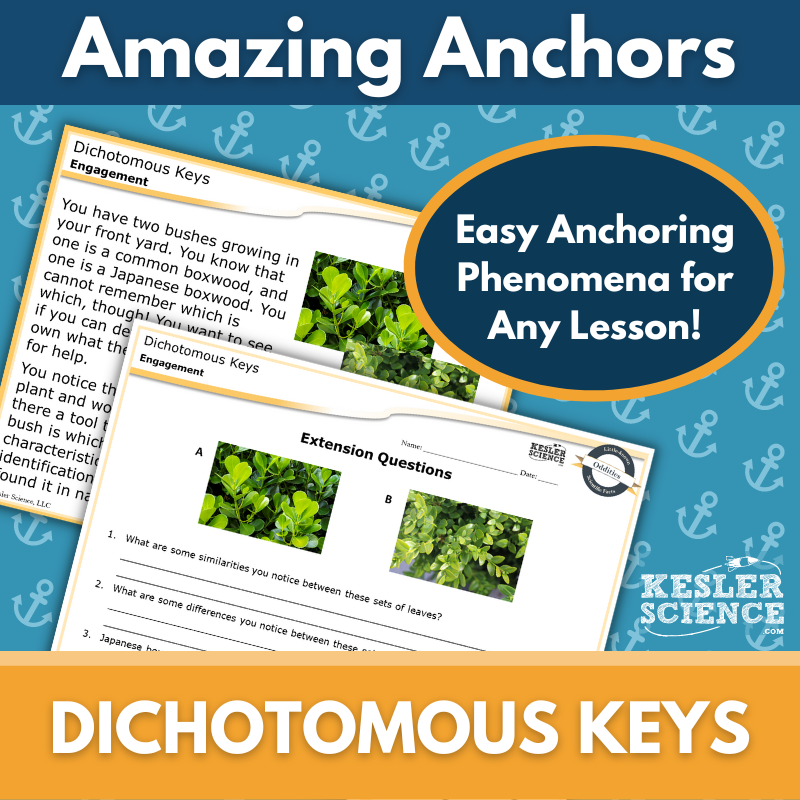Dichotomous Keys Activities for Middle School Science
The Kesler Science Dichotomous Keys resources guides middle school students in identifying organisms or objects using a dichotomous key through engaging, TEKS-aligned activities. The resources below will give students a comprehensive understanding of dichotomous keys. All of the following materials are also included in the Kesler Science Membership.
The Kesler Science Dichotomous Keys 5E Lesson is a comprehensive, low-prep unit designed to help middle school students identify organisms or objects using a dichotomous key. Fully aligned with the 2021 TEKS standards, this lesson includes editable presentations, vocabulary resources in English and Spanish, and teacher-led engagement activities to spark curiosity and address common misconceptions.
Students will explore the topic through a differentiated, student-led station lab featuring nine multimodal activities. Input stations include reading passages, videos, and websites, while output stations allow students to organize, write, illustrate, and assess their understanding. A bonus “Challenge It!” station encourages deeper exploration for early finishers. All materials are available in print and digital formats to suit diverse classroom needs.
The unit continues with editable PowerPoints, interactive notebook templates, and guided notes for clear explanation. Students can elaborate their learning through choice-based projects and demonstrate mastery with STAAR 2.0-aligned assessments, review questions, and worksheets. Designed for maximum flexibility, the entire lesson can be used seamlessly in both classroom and virtual settings.
The Kesler Science Dichotomous Keys 5E Lesson is a comprehensive, low-prep unit designed to help middle school students identify organisms or objects using a dichotomous key. Fully aligned with the 2021 TEKS standards, this lesson includes editable presentations, vocabulary resources in English and Spanish, and teacher-led engagement activities to spark curiosity and address common misconceptions.
Students will explore the topic through a differentiated, student-led station lab featuring nine multimodal activities. Input stations include reading passages, videos, and websites, while output stations allow students to organize, write, illustrate, and assess their understanding. A bonus “Challenge It!” station encourages deeper exploration for early finishers. All materials are available in print and digital formats to suit diverse classroom needs.
The unit continues with editable PowerPoints, interactive notebook templates, and guided notes for clear explanation. Students can elaborate their learning through choice-based projects and demonstrate mastery with STAAR 2.0-aligned assessments, review questions, and worksheets. Designed for maximum flexibility, the entire lesson can be used seamlessly in both classroom and virtual settings.
This modular, student-led station lab engages middle school students in learning how to identify and compare characteristics using dichotomous keys. Designed to support a personalized learning experience, the lab features nine stations—eight core activities plus a challenge extension—allowing students to explore the content at their own pace while the teacher facilitates learning. The resource is compatible with both in-person and virtual formats, using PowerPoint and Google Slides, and includes all necessary signage, task cards, and materials.
Students encounter new concepts through input stations that include watching videos, reading passages (available in English and Spanish), conducting online research, and participating in hands-on demonstrations. Output stations allow students to demonstrate understanding by organizing data with manipulatives, illustrating concepts, writing responses, and completing assessments. The Challenge It! station offers enriching tasks like games, crosswords, and mini-projects for early finishers or advanced learners.
Part of the larger Dichotomous Keys 5E Lesson Plan, this lab supports differentiation and multimodal learning. This comprehensive and flexible activity provides everything needed to engage students deeply in the study of dichotomous keys.
This modular, student-led station lab engages middle school students in learning how to identify and compare characteristics using dichotomous keys. Designed to support a personalized learning experience, the lab features nine stations—eight core activities plus a challenge extension—allowing students to explore the content at their own pace while the teacher facilitates learning. The resource is compatible with both in-person and virtual formats, using PowerPoint and Google Slides, and includes all necessary signage, task cards, and materials.
Students encounter new concepts through input stations that include watching videos, reading passages (available in English and Spanish), conducting online research, and participating in hands-on demonstrations. Output stations allow students to demonstrate understanding by organizing data with manipulatives, illustrating concepts, writing responses, and completing assessments. The Challenge It! station offers enriching tasks like games, crosswords, and mini-projects for early finishers or advanced learners.
Part of the larger Dichotomous Keys 5E Lesson Plan, this lab supports differentiation and multimodal learning. This comprehensive and flexible activity provides everything needed to engage students deeply in the study of dichotomous keys.
The Kesler Science Dichotomous Keys Student Choice Projects empower middle school students to demonstrate their knowledge through creative, personalized options. With six unique project ideas and a “design your own” option, students can choose the format that best suits their learning style. A flexible grading rubric allows for teacher, peer, or self-assessment.
This resource provides differentiated support to meet diverse student needs. The modified project page includes targeted options for students requiring remediation, while advanced learners can be challenged with multiple projects. Editable rubrics assess vocabulary, concepts, presentation, clarity, and accuracy, ensuring comprehensive evaluation.
Designed for flexibility, the projects require standard classroom supplies like paper, markers, and scissors, with many options available for digital completion. The Kesler Science Student Choice Projects offer an engaging way for students to explore dichotomous keys while fostering creativity and independence.
The Kesler Science Dichotomous Keys Student Choice Projects empower middle school students to demonstrate their knowledge through creative, personalized options. With six unique project ideas and a “design your own” option, students can choose the format that best suits their learning style. A flexible grading rubric allows for teacher, peer, or self-assessment.
This resource provides differentiated support to meet diverse student needs. The modified project page includes targeted options for students requiring remediation, while advanced learners can be challenged with multiple projects. Editable rubrics assess vocabulary, concepts, presentation, clarity, and accuracy, ensuring comprehensive evaluation.
Designed for flexibility, the projects require standard classroom supplies like paper, markers, and scissors, with many options available for digital completion. The Kesler Science Student Choice Projects offer an engaging way for students to explore dichotomous keys while fostering creativity and independence.
The Kesler Science Structure of Life Interactive Notebook Bundle provides an engaging way for students to explore life science concepts through interactive activities. Designed for both print and digital use, this resource is perfect for traditional classrooms, 1:1 environments, and distance learning. Topics covered include cell theory, genetics, plant and animal cells, and more, offering a comprehensive tool for teaching the structure of life.
The digital version includes a unique interactive notebook PowerPoint that can be uploaded to platforms like Google Slides or MS Teams, complete with reflection pages, note spaces, and an answer key. A modified digital version is also provided for students needing accommodations. The paper version features blank and pre-filled templates, along with color photos to guide usage, ensuring all students can participate effectively.
With resources tailored for diverse learning needs, the Kesler Science Structure of Life Interactive Notebook Bundle supports differentiated instruction and student-centered learning. Teachers gain a versatile tool for enhancing understanding, while students build lasting connections to key life science concepts.
The Kesler Science Structure of Life Interactive Notebook Bundle provides an engaging way for students to explore life science concepts through interactive activities. Designed for both print and digital use, this resource is perfect for traditional classrooms, 1:1 environments, and distance learning. Topics covered include cell theory, genetics, plant and animal cells, and more, offering a comprehensive tool for teaching the structure of life.
The digital version includes a unique interactive notebook PowerPoint that can be uploaded to platforms like Google Slides or MS Teams, complete with reflection pages, note spaces, and an answer key. A modified digital version is also provided for students needing accommodations. The paper version features blank and pre-filled templates, along with color photos to guide usage, ensuring all students can participate effectively.
With resources tailored for diverse learning needs, the Kesler Science Structure of Life Interactive Notebook Bundle supports differentiated instruction and student-centered learning. Teachers gain a versatile tool for enhancing understanding, while students build lasting connections to key life science concepts.
The Kesler Science Dichotomous Keys Inquiry Lab engages students in either a digital or hands-on investigation where they sort leaves based on observable characteristics and identify structures such as shape, margin, and venation. After building familiarity with these features, students use a dichotomous key to identify “mystery” leaves, promoting understanding of how scientists classify plant species.
Both the print and digital formats include three differentiated versions—Modified, Dependent, and Independent—so teachers can meet the needs of diverse learners. Modified versions offer the most structure, Dependent versions blend guidance with inquiry, and Independent versions allow students to take the lead. All versions include comprehension questions, CER writing prompts, and reflection opportunities to reinforce learning.
The lab is fully editable and designed for flexibility, with digital versions compatible with Google Slides and print versions ready for classroom use. Teacher resource pages and answer keys are included to support planning and assessment. This engaging activity helps students explore classification systems in a meaningful, hands-on way.
The Kesler Science Dichotomous Keys Inquiry Lab engages students in either a digital or hands-on investigation where they sort leaves based on observable characteristics and identify structures such as shape, margin, and venation. After building familiarity with these features, students use a dichotomous key to identify “mystery” leaves, promoting understanding of how scientists classify plant species.
Both the print and digital formats include three differentiated versions—Modified, Dependent, and Independent—so teachers can meet the needs of diverse learners. Modified versions offer the most structure, Dependent versions blend guidance with inquiry, and Independent versions allow students to take the lead. All versions include comprehension questions, CER writing prompts, and reflection opportunities to reinforce learning.
The lab is fully editable and designed for flexibility, with digital versions compatible with Google Slides and print versions ready for classroom use. Teacher resource pages and answer keys are included to support planning and assessment. This engaging activity helps students explore classification systems in a meaningful, hands-on way.
The Kesler Science Dichotomous Keys Sub Plans provide a complete, engaging lesson that ensures your classroom runs smoothly in your absence. Students begin with a warm-up puzzle, followed by reading a passage and using a dichotomous key to identify unknown creatures. Early finishers can create their own dichotomous keys or analyze the term "dichotomous" with sketches. The lesson concludes with an assessment or exit ticket to reinforce understanding.
Designed with substitutes and distance learning in mind, the sub plans include extensive instructions, a substitute letter, and behavior checkpoints to maintain classroom management. The digital version offers editable PDFs, Google Form answer sheets, and compatibility with PDF annotation tools like Kami, making it easy to adapt for remote learning or at-home assignments.
Each sub plan includes everything needed for seamless implementation: answer keys, student instructions, and engaging activities to minimize downtime. These versatile resources can be used for substitutes, ISS students, extra credit, or small group work, ensuring a productive and stress-free day for everyone.
The Kesler Science Dichotomous Keys Sub Plans provide a complete, engaging lesson that ensures your classroom runs smoothly in your absence. Students begin with a warm-up puzzle, followed by reading a passage and using a dichotomous key to identify unknown creatures. Early finishers can create their own dichotomous keys or analyze the term "dichotomous" with sketches. The lesson concludes with an assessment or exit ticket to reinforce understanding.
Designed with substitutes and distance learning in mind, the sub plans include extensive instructions, a substitute letter, and behavior checkpoints to maintain classroom management. The digital version offers editable PDFs, Google Form answer sheets, and compatibility with PDF annotation tools like Kami, making it easy to adapt for remote learning or at-home assignments.
Each sub plan includes everything needed for seamless implementation: answer keys, student instructions, and engaging activities to minimize downtime. These versatile resources can be used for substitutes, ISS students, extra credit, or small group work, ensuring a productive and stress-free day for everyone.
The Kesler Science Dichotomous Keys Escape Room provides an immersive way for students to demonstrate their understanding of dichotomous keys. This engaging activity offers eight independent puzzles, allowing teachers to customize the experience to fit their schedule. The escape room encourages critical thinking and teamwork while making science concepts fun and memorable.
Teachers can run the escape room using simple materials like printed puzzles and manila envelopes or create a more authentic experience with lockout hasps, combination locks, and storage boxes. The activity includes detailed teacher directions, printable props, and a variety of materials to enhance the experience. Digital options are also available, with single-student versions in PowerPoint or Google Slides for virtual learning environments.
This resource includes everything you need: editable teacher files, answer keys, a digital answer sheet, and a video challenge to set the tone. Students can work in groups or individually, with prizes and reward templates to celebrate their success. With its flexible format and engaging content, this escape room is perfect for reinforcing science concepts in any learning environment.
The Kesler Science Dichotomous Keys Escape Room provides an immersive way for students to demonstrate their understanding of dichotomous keys. This engaging activity offers eight independent puzzles, allowing teachers to customize the experience to fit their schedule. The escape room encourages critical thinking and teamwork while making science concepts fun and memorable.
Teachers can run the escape room using simple materials like printed puzzles and manila envelopes or create a more authentic experience with lockout hasps, combination locks, and storage boxes. The activity includes detailed teacher directions, printable props, and a variety of materials to enhance the experience. Digital options are also available, with single-student versions in PowerPoint or Google Slides for virtual learning environments.
This resource includes everything you need: editable teacher files, answer keys, a digital answer sheet, and a video challenge to set the tone. Students can work in groups or individually, with prizes and reward templates to celebrate their success. With its flexible format and engaging content, this escape room is perfect for reinforcing science concepts in any learning environment.
The Kesler Science Dichotomous Keys Reading Comprehension Activity introduces middle school students to the use of dichotomous keys for organism identification through a nonfiction article. Students enhance their understanding by answering comprehension questions and creating their own dichotomous keys, fostering both science literacy and critical thinking. With leveled Lexile passages (1100–1300), this resource caters to grades 6–8 and advanced 5th graders, ensuring accessibility and engagement.
This resource includes a variety of tools to support learning, such as Cornell notes templates, colorful graphics, and a hands-on mini-project. Teachers can incorporate the activity into their classrooms or assign it digitally through platforms like Google Classroom and MS Teams. The reading passages and activities are versatile, making them ideal for whole-class instruction, extra credit, sub plans, or as part of a routine to build science comprehension.
Designed for both in-person and virtual learning, this activity promotes classroom discussions and textual analysis while reinforcing essential science concepts. Whether used for distance learning or on-campus instruction, it equips students with the skills to analyze, understand, and apply scientific information effectively.
The Kesler Science Dichotomous Keys Reading Comprehension Activity introduces middle school students to the use of dichotomous keys for organism identification through a nonfiction article. Students enhance their understanding by answering comprehension questions and creating their own dichotomous keys, fostering both science literacy and critical thinking. With leveled Lexile passages (1100–1300), this resource caters to grades 6–8 and advanced 5th graders, ensuring accessibility and engagement.
This resource includes a variety of tools to support learning, such as Cornell notes templates, colorful graphics, and a hands-on mini-project. Teachers can incorporate the activity into their classrooms or assign it digitally through platforms like Google Classroom and MS Teams. The reading passages and activities are versatile, making them ideal for whole-class instruction, extra credit, sub plans, or as part of a routine to build science comprehension.
Designed for both in-person and virtual learning, this activity promotes classroom discussions and textual analysis while reinforcing essential science concepts. Whether used for distance learning or on-campus instruction, it equips students with the skills to analyze, understand, and apply scientific information effectively.
The Kesler Science Dichotomous Keys Writing Prompt Activity engages middle school students in identifying and classifying organisms through creative, student-centered writing exercises. This activity, designed as a travel brochure prompt, encourages science reasoning and exploration while reinforcing their knowledge of life science topics like the digestive system. With virtual learning compatibility, students can participate in the activity both in-person and online.
Included materials offer flexibility and ease of use, featuring teacher directions, answer guides, full- and half-sheet handouts, and a digital interactive version compatible with PowerPoint and Google Slides. Pre-writing strategies and templates support student creativity while ensuring alignment with learning goals.
Ideal for cross-curricular activities, formative assessments, or extra credit, this low-prep resource is perfect for elaboration, early finishers, or differentiated instruction. It integrates seamlessly with other Kesler Science products and provides engaging opportunities for students to demonstrate understanding through writing.
The Kesler Science Dichotomous Keys Writing Prompt Activity engages middle school students in identifying and classifying organisms through creative, student-centered writing exercises. This activity, designed as a travel brochure prompt, encourages science reasoning and exploration while reinforcing their knowledge of life science topics like the digestive system. With virtual learning compatibility, students can participate in the activity both in-person and online.
Included materials offer flexibility and ease of use, featuring teacher directions, answer guides, full- and half-sheet handouts, and a digital interactive version compatible with PowerPoint and Google Slides. Pre-writing strategies and templates support student creativity while ensuring alignment with learning goals.
Ideal for cross-curricular activities, formative assessments, or extra credit, this low-prep resource is perfect for elaboration, early finishers, or differentiated instruction. It integrates seamlessly with other Kesler Science products and provides engaging opportunities for students to demonstrate understanding through writing.
The Kesler Science Ecosystems WIKI Tickets are versatile formative assessments designed for 6th-8th grade science topics. These engaging assessments come in five formats for each topic: full screen for projection, three handout sizes (full, split, and quarter-page), and a digital interactive version that can be used as an editable PPT or Google Slides file. Perfect for checking understanding, these WIKI Tickets provide flexible options for in-person and virtual learning environments.
Aligned with NGSS and TEKS standards, each WIKI Tickets set includes a variety of topics like biodiversity, ecosystems, dichotomous keys, and human impact. A bonus table of contents helps teachers quickly find the alignment for each standard. Some topics even have multiple tickets to reinforce key concepts and support student learning.
These assessments are ideal for use as exit tickets, bellringers, or anytime you need quick feedback on student progress. With digital and print formats available, they can be easily adapted for any classroom setting, providing a fun and effective way to gauge students' understanding of science concepts.
The Kesler Science Ecosystems WIKI Tickets are versatile formative assessments designed for 6th-8th grade science topics. These engaging assessments come in five formats for each topic: full screen for projection, three handout sizes (full, split, and quarter-page), and a digital interactive version that can be used as an editable PPT or Google Slides file. Perfect for checking understanding, these WIKI Tickets provide flexible options for in-person and virtual learning environments.
Aligned with NGSS and TEKS standards, each WIKI Tickets set includes a variety of topics like biodiversity, ecosystems, dichotomous keys, and human impact. A bonus table of contents helps teachers quickly find the alignment for each standard. Some topics even have multiple tickets to reinforce key concepts and support student learning.
These assessments are ideal for use as exit tickets, bellringers, or anytime you need quick feedback on student progress. With digital and print formats available, they can be easily adapted for any classroom setting, providing a fun and effective way to gauge students' understanding of science concepts.
The Kesler Science Structure of Life Lesson Extensions provide student-choice activities designed to keep fast finishers engaged with critical thinking and creative tasks. These extensions are perfect for wrapping up lessons, filling time during testing, or offering advanced learners opportunities to deepen their understanding of life science concepts. Aligned with NGSS and TEKS standards, the extensions include activities such as puzzles, hands-on Maker Space projects, digital media tasks, and creative writing challenges.
Each Lesson Extension includes teacher directions, answer keys, and both projection and printable versions for maximum flexibility. With topics ranging from cell structure to heredity and natural selection, students can explore concepts through problem-solving, STEAM connections, and creative expression. These activities encourage deeper exploration of topics like artificial selection, genetic mutations, and environmental factors.
Kesler Science Lesson Extensions are ideal for scaffolding learning or challenging independent learners. By incorporating engaging activities like Puzzler, Maker Space, Tech Connection, and Word Master, these resources provide rigorous yet enjoyable options to enrich life science lessons.
The Kesler Science Structure of Life Lesson Extensions provide student-choice activities designed to keep fast finishers engaged with critical thinking and creative tasks. These extensions are perfect for wrapping up lessons, filling time during testing, or offering advanced learners opportunities to deepen their understanding of life science concepts. Aligned with NGSS and TEKS standards, the extensions include activities such as puzzles, hands-on Maker Space projects, digital media tasks, and creative writing challenges.
Each Lesson Extension includes teacher directions, answer keys, and both projection and printable versions for maximum flexibility. With topics ranging from cell structure to heredity and natural selection, students can explore concepts through problem-solving, STEAM connections, and creative expression. These activities encourage deeper exploration of topics like artificial selection, genetic mutations, and environmental factors.
Kesler Science Lesson Extensions are ideal for scaffolding learning or challenging independent learners. By incorporating engaging activities like Puzzler, Maker Space, Tech Connection, and Word Master, these resources provide rigorous yet enjoyable options to enrich life science lessons.
This Amazing Anchors Phenomenon Lesson introduces and reinforces dichotomous keys through real-world connections. Students begin with an engaging reading about identifying plants in a garden, followed by comprehension and extension questions to spark curiosity and build background knowledge. A second reading explains how dichotomous keys work, providing additional questions that deepen student understanding.
The resource includes teacher directions, answer keys, and editable materials in both print and digital formats. Full-page projection slides and half-sheet handouts support flexible classroom use, while digital versions work seamlessly with Google Classroom and other LMS platforms. A modified version with sentence starters is also included to support differentiated learning.
Designed to bookend a core science lesson, Amazing Anchors can be used during the Engagement and Elaborate phases of the 5E model. These no-prep, TEKS-aligned readings are ideal for introducing or reinforcing the concept of classification through dichotomous keys in any middle school setting.
This Amazing Anchors Phenomenon Lesson introduces and reinforces dichotomous keys through real-world connections. Students begin with an engaging reading about identifying plants in a garden, followed by comprehension and extension questions to spark curiosity and build background knowledge. A second reading explains how dichotomous keys work, providing additional questions that deepen student understanding.
The resource includes teacher directions, answer keys, and editable materials in both print and digital formats. Full-page projection slides and half-sheet handouts support flexible classroom use, while digital versions work seamlessly with Google Classroom and other LMS platforms. A modified version with sentence starters is also included to support differentiated learning.
Designed to bookend a core science lesson, Amazing Anchors can be used during the Engagement and Elaborate phases of the 5E model. These no-prep, TEKS-aligned readings are ideal for introducing or reinforcing the concept of classification through dichotomous keys in any middle school setting.
Year-Round Resources
These year-round activities will increase your students' understanding of many middle school science topics. All of these activities are also included in the Kesler Science Membership.
Visual Data & Graphing
You're not alone if your students struggle with understanding graphs, charts, and tables. It's a skill that takes an enormous amount of practice. This resource will help students build a strong foundation in analyzing data and creating their own data visualizations.
Bell Ringers and Warm-Ups
These middle school science bell ringers are an excellent way to engage your students as soon as they walk into your classroom. This comprehensive FULL YEAR resource includes everything you need to start off each science class with an interesting warm-up activity.
Review Board Games
Each game board has been carefully designed to keep students engaged. There are 10 different action spaces on each board and dozens of question cards. All of the actions are related to science concepts and keep the students motivated throughout the game.
Each game is ready to play. Simply print out the board and the cards and let the students enjoy reviewing nine different units.
Essential Questions
Below are the essential questions associated with the lessons and activities included in this unit. This topic is only one of more than 100 middle school science topics included in the Kesler Science Membership.
-
How can you identify organisms or objects using a dichotomous key?
Kesler Science Membership
Imagine never having to search for another middle school science lesson again. The membership gives you access to ALL of the Kesler Science products in one place (Yes, including everything above).
Say goodbye to long hours of lesson prep.

